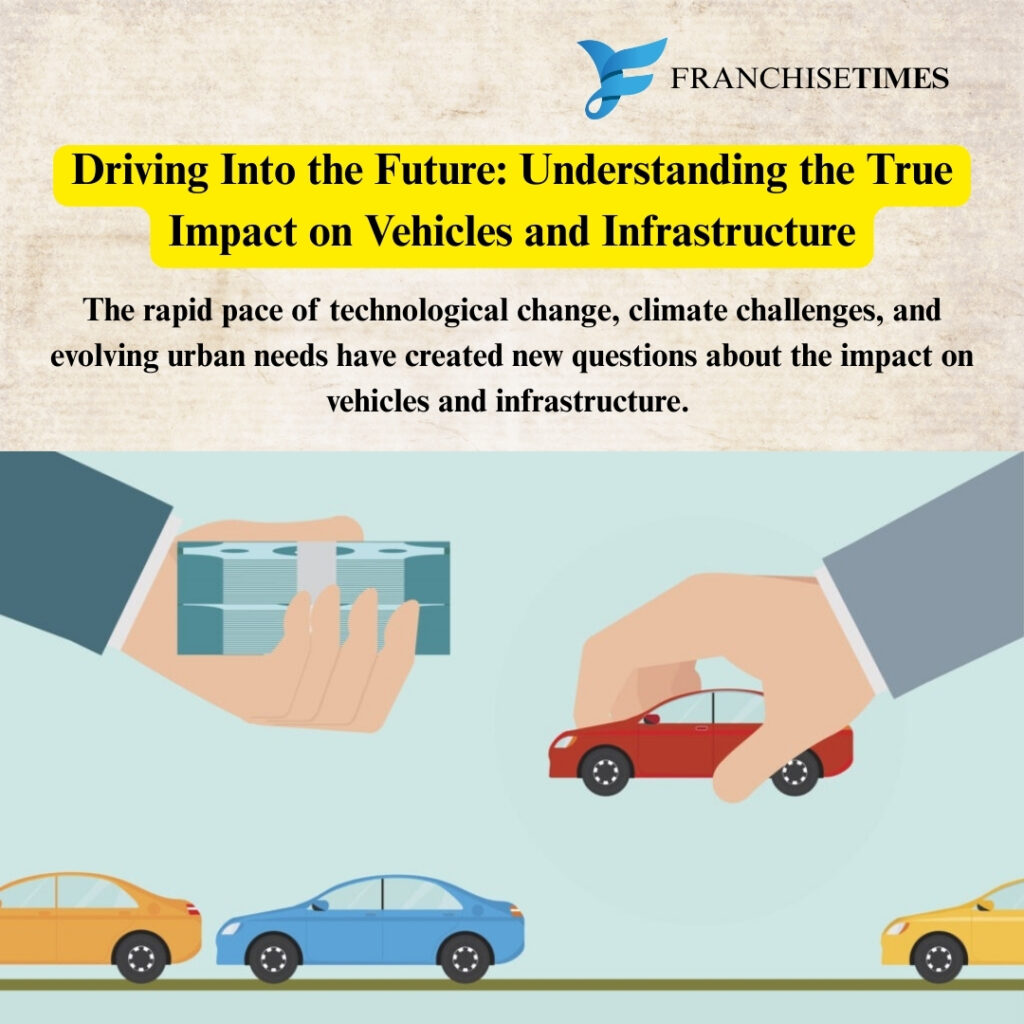Driving Into the Future: Understanding the True Impact on Vehicles and Infrastructure
Transportation is the backbone of any economy. Every road, bridge, and vehicle plays a part in connecting people, goods, and services. Yet, the rapid pace of technological change, climate challenges, and evolving urban needs have created new questions about the Future of Vehicle Infrastructure. Understanding this relationship is essential for policymakers, industries, and individuals alike.

In this blog, we’ll explore how vehicles and infrastructure affect one another, the challenges they face, and the future opportunities ahead.
1. Evolution of Transportation Systems and Its Impact on Vehicles and Infrastructure
Transportation has never remained static. From horse-drawn carriages to high-speed trains and electric vehicles, every phase of progress has reshaped mobility and the supporting infrastructure. The Future of Vehicle Infrastructure can be seen through several layers of transformation.
First, consider the industrial revolution. Steam engines pushed road networks to expand rapidly. Later, the invention of the internal combustion engine demanded stronger highways and fueling stations. The 20th century brought highways, tunnels, and bridges designed for mass automobile travel. This clearly shows how innovations in vehicles shape infrastructure.
Second, infrastructure directly influences vehicles. Roads with poor maintenance damage engines and tires. On the other hand, modern highways encourage fuel efficiency and safety features. Thus, the cycle continues: as vehicles improve, infrastructure upgrades become necessary, and vice versa.
Third, globalization expanded these changes. Global trade required ports, airports, and logistics hubs. At the same time, container trucks and cargo aircraft had to match the needs of global commerce. The impact on vehicles and infrastructure therefore reached international dimensions, affecting economic growth.
Finally, technology has created smarter systems. Digital tolling, GPS navigation, and connected transport networks rely on synchronized upgrades in both vehicles and infrastructure. Without smart roads, autonomous vehicles cannot achieve their full potential.
2. Environmental Challenges and Their Impact on Vehicles and Infrastructure
Sustainability is now at the center of global debates. Climate change, pollution, and natural resource depletion all shape the impact on vehicles and infrastructure.
First, vehicle emissions remain a critical issue. Traditional fuel-based engines contribute to carbon dioxide and particulate pollution. In response, infrastructure must adapt with electric charging stations, hydrogen fueling systems, and stricter emission-monitoring frameworks. Without these upgrades, cleaner vehicles cannot succeed.
Second, extreme weather events directly affect roads, bridges, and railways. Floods damage highways, heatwaves warp rail tracks, and storms weaken bridges. These effects increase maintenance costs and reduce the lifespan of infrastructure. Consequently, vehicles also suffer more breakdowns and delays.
Third, sustainability goals push cities to redesign infrastructure. Bus rapid transit lanes, cycling tracks, and pedestrian pathways reduce private car dependency. Electric buses, hybrid cars, and shared mobility solutions thrive in such systems. Thus, the impact on vehicles and infrastructure reflects a deeper link with environmental policy.
Fourth, raw material concerns also matter. Lithium for batteries, steel for bridges, and asphalt for highways all face sustainability challenges. Both vehicle manufacturers and infrastructure developers must balance innovation with resource management.
Finally, energy efficiency stands as a unifying theme. Smart traffic lights reduce fuel waste, while smooth roads extend vehicle life. In short, eco-friendly infrastructure directly benefits vehicles and reduces emissions simultaneously.
3. Technological Innovations Reshaping the Impact on Vehicles and Infrastructure
Technology is revolutionizing transportation faster than ever before. Innovations in artificial intelligence, automation, and digital connectivity create a powerful impact on vehicles and infrastructure.
First, smart vehicles require intelligent infrastructure. Autonomous cars need high-definition maps, real-time sensors, and seamless communication with roads. Without 5G networks, vehicle-to-infrastructure (V2I) communication cannot work effectively. Thus, infrastructure must evolve in sync with vehicles.
Second, predictive maintenance is transforming both sectors. Vehicles now carry sensors that detect early faults. Similarly, bridges and roads are being equipped with monitoring devices. This real-time data exchange reduces accidents, increases safety, and lowers costs.
Third, shared mobility platforms such as ride-hailing and car-sharing depend on digital infrastructure. Apps, cloud computing, and GPS systems connect vehicles with passengers seamlessly. The impact on vehicles and infrastructure is visible in cities redesigning parking lots into charging hubs for shared fleets.
Fourth, the electric revolution highlights how technology drives integration. Battery-powered cars demand widespread charging stations. Grid management systems ensure power supply stability. At the same time, vehicle-to-grid technology allows cars to return electricity to the system during peak demand.
Finally, futuristic transport modes like hyperloops and flying taxis will reshape everything. They require entirely new infrastructure, materials, and safety systems. Vehicles designed for these systems will also differ radically from today’s models. Thus, the impact remains dynamic, continuous, and deeply technological.
4. Economic and Social Dimensions of the Impact on Vehicles and Infrastructure
The relationship between vehicles and infrastructure is not just about technology. It also carries strong economic and social implications. The impact on vehicles and infrastructure directly affects productivity, employment, and quality of life.
First, consider job creation. Infrastructure projects such as highways, metro systems, and airports employ thousands. Vehicle industries, from manufacturing to servicing, also create massive employment opportunities. A healthy balance between both sectors ensures economic stability.
Second, mobility drives productivity. Efficient roads reduce delivery delays, while reliable vehicles lower transport costs. This synergy benefits businesses and consumers. Without strong infrastructure, even advanced vehicles cannot ensure timely services.
Third, accessibility improves equality. Well-designed transport networks allow rural communities to connect with urban centers. Affordable vehicles, combined with inclusive infrastructure, reduce barriers for education, healthcare, and employment. The impact on vehicles and infrastructure therefore carries social justice dimensions.
Fourth, costs must be managed carefully. Infrastructure requires huge investments, while vehicles carry rising production costs. Governments often subsidize cleaner vehicles or smart infrastructure, but budget pressures remain a challenge.
Finally, safety is paramount. Poorly built infrastructure causes accidents, while unsafe vehicles worsen the risks. Safety standards must therefore cover both sides equally. Only when vehicles and infrastructure are aligned can road safety targets be achieved.
5. Future Outlook: Building Sustainable Synergy Between Vehicles and Infrastructure
Looking ahead, the future demands smarter, greener, and more resilient systems. The Future of Vehicle Infrastructure will continue to expand as societies grow more urbanized and technology-driven.
First, electric and autonomous mobility will dominate. This shift requires charging grids, AI-driven traffic systems, and safer road designs. Vehicles and infrastructure will no longer be separate but deeply interconnected.
Second, cities must prioritize resilience. Infrastructure must withstand floods, earthquakes, and extreme temperatures. Vehicles should also adapt, with improved cooling systems, waterproofing, and durability. This synergy ensures uninterrupted mobility even under stress.
Third, investment strategies must align with sustainability. Public-private partnerships, green bonds, and international cooperation can finance large-scale projects. By doing so, governments ensure both infrastructure upgrades and vehicle innovation.
Fourth, collaboration is essential. Automakers, urban planners, policymakers, and tech companies must work together. No single sector can handle the growing challenges alone. Strong partnerships accelerate progress and reduce costs.
Finally, the vision for the future must focus on people. Vehicles and infrastructure exist to serve society, not the other way around. Every innovation must prioritize safety, accessibility, affordability, and environmental responsibility. In this way, the impact on vehicles and infrastructure will become a force for progress rather than a burden.
Conclusion
The Future of Vehicle Infrastructure is far-reaching. From industrial revolutions to modern AI-driven systems, both have grown together, shaping economies and daily lives. Environmental concerns, technological shifts, economic pressures, and social needs all influence how vehicles and infrastructure evolve.
Moving forward, creating synergy between the two is not an option—it is a necessity. Smarter roads, cleaner vehicles, resilient systems, and inclusive designs will define the next era of transportation. Ultimately, the journey is not just about vehicles or infrastructure, but about building sustainable mobility that benefits everyone.
